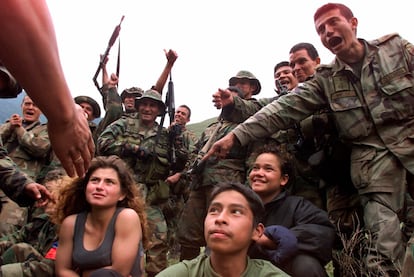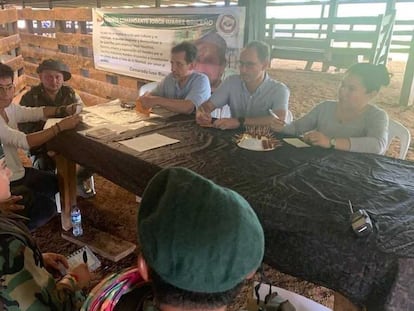The forced recruitment of child soldiers in Colombia: Families are uprooted, isolated and threatened
Four minors were murdered by FARC dissidents, once again highlighting the extent of the war crime in the South American nation

Edalid Carrillo had no choice but to take her 13-year-old son from his birthplace. She did so to protect him from illegal armed groups, after the February 2022 murder of her child’s father, Herman Naranjo Quintero, a social leader in Corocito, a village in the municipality of Tame (Arauca), Colombia. The woman’s public pleas to spare her kidnapped husband’s life were not enough to prevent his assassination. Unprotected, Carrillo decided to leave the area. She also feared losing her son to forced child recruitment and continuing to endure the horror of war.
As time has gone by, Carrillo’s case has been forgotten, but the misfortune of families like hers continues in areas where the state lacks a strong presence. The recent murder of four indigenous minors from Putumayo on the border between Caquetá and Amazonas, after being recruited by the Carolina Ramírez Front from the defunct Revolutionary Armed Forces of Colombia (FARC) once again highlighted the extent of the problem in Colombia. Parents confront silence and threats and uproot themselves in an effort to prevent illegal groups from taking their children and teenagers away from them.
In towns as exposed to the armed conflict as Tame, in eastern Colombia, the families of high-risk youths have sacrificed proximity to their children in order to keep them safe. The municipality ombudsman, Juan Carlos Villate, has led efforts to protect some of them, removing them from their homes after an urgent call from their families, once they manage to break the silence imposed by the conflict.
“During these interventions, the communities feel confident, and they talk; they say: ‘look, they are going to take my child away, please help us.’ We began to activate routes for removing children from the territory with international organizations’ support, but we only identify them when we are in the village,” says Villate in an interview with EL PAÍS. Early last year, one such operation was carried out with other organizations in Caranal, a hamlet in the Fortul municipality, where seven children were at risk of falling into the hands of illegal groups.
Few officials risk going to threatened communities, most of which are indigenous. “Public order [concerns] mean that they are served from afar. It is natural for [people to be afraid]. The guerrillas have detained my work team several times,” the Tame ombudsman admits. according to the Ombudsman’s Office’s records, since 2022, 11 Makaguán indigenous girls have been recruited from the La Esperanza reservation, in the Siberia I district, including two this year.
The Ombudsman’s Office has recorded 23 cases of the recruitment of minors between 13 and 17 years of age in the first quarter of this year, in the departments of Cauca, Amazonas, Antioquia and Arauca. That is eight more children than the number reported in the same period last year. But the figures—which reveal an increase of over 50%—do not always reflect the gravity of the problem. “If they speak out, families are at risk in their territory. That is why it is not easy to identify cases,” the ombudsman says.
According to data analyzed by the Truth Commission, between 1990 and 2017, armed groups recruited 16,238 minors in Colombia. “They were girls and boys without the ability to decide [for themselves] because of their age and social conditions; they didn’t have the chance to escape the war,” the Commission’s final report emphasizes.
A UNICEF study on the children who have been freed from organized armed groups in Colombia between 2013 and 2022 shows that, of the 2,181 children and teenagers served by the specialized care program of the Colombian Institute of Family Welfare (ICBF), 40% were recruited by the defunct FARC and about 27% by the ELN. The rest were recruited by other groups such as the Clan del Golfo [Gulf Clan] and Gaitanist Self-Defense Forces (AGC). Nearly four out of every 10 demobilized children belong to indigenous or Afro-Colombian communities, indicating that this crime affects more vulnerable populations that have historically faced discrimination.
Although the recruitment of minors lessened during the peace process between the government and the FARC from 2012 to 2016, the armed groups’ eagerness to strengthen their organizations and dominate territories has triggered a new cycle of violence that once again threatens youngsters. “Little girls, little boys and teenagers [who are] at risk of recruitment already live in a permanent situation of rights violations in their territories,” the UNICEF report states.
Although doing so is considered a war crime, armed groups employ a variety of tactics to entice minors to join their ranks. The dissidents take advantage of the structures of weak households, children out of school, indigenous communities and Venezuelan migrants. For its part, the ELN resorts to false promises. “They make the children fall in love, they tell them that it is an adrenaline rush, that nothing is going to happen [to them], that [the ELN] is going to give them money, a motorcycle, authority, women... and the children end up joining. When they realize that life is not what they were promised and try to leave, they are not allowed to do so. The ones who have tried [to escape] have been killed,” says Tame’s ombudsman, Juan Carlos Villate.
“There are cases of children being used as cannon fodder in the fighting,” he adds. He provides the example of the clashes between the National Liberation Army (ELN) and the Colombian army on March 19 in the rural area of his municipality, in which a 17-year-old boy who had been recruited by this illegal group was killed.
In regions where forced recruitment is a constant fear, minors are also subject to confinement to keep them safe. Mayerly Briceño, a young social leader from Arauca who now lives in Bogotá, experienced that as a child. “I grew up in a space where conflict [defined] daily life. I never had the opportunity to know what it was like to go play with friends outside. Today, I understand my mother’s fear and why she didn’t want my sisters and me to go outside, so that we wouldn’t be exposed,” she recalls.
Briceño is now the mother of a 10-year-old son. She laments that this reality continues to repeat itself. “When you grow up and have a child, you start to look back, and you look for ways to protect him. He only goes from home to school and from school to home. He doesn’t go into town…because we don’t know when there might be a confrontation,” she says. She plans to remove her son from the territory.
Some of the minors rescued from recruitment receive shelter from organizations like Benposta, an NGO that works to protect children affected by the conflict. Project coordinator Juan Sebastián Campo says that banishment should be the last resort. The most effective prevention, he says, is guaranteeing them rights and opportunities. “There is enough information about the reasons that minors get involved in the war. Many are children who [are] literally tired of domestic violence, economic precarity or [having] nothing to eat, and end up fleeing and joining armed groups,” says Campo.
“What else can they do when every[thing] is closed [to them]? There are always the armed groups trying to see how they can get them involved in the war, and unfortunately that is what happens. I know of many, many cases of young people who can’t find any other option in life. It is sad, but that’s the reality of this country, and we are still experiencing it today,” says Mayerly Briceño.
After the Carolina Ramírez Front murdered the four recruited minors, President Gustavo Petro suspended the ceasefire in the departments of Meta, Caquetá, Guaviare and Putumayo. “Killing indigenous children is an unacceptable crime against humanity. Forcibly recruiting minors is the same,” the Colombian president said. With or without a ceasefire, families in conflict-stricken territories face a lonely effort to protect their children from violence. Some cries for help are stuck between a rock and a hard place. Others, like Edalid Carrillo’s, are not always heard.
Sign up for our weekly newsletter to get more English-language news coverage from EL PAÍS USA Edition
Tu suscripción se está usando en otro dispositivo
¿Quieres añadir otro usuario a tu suscripción?
Si continúas leyendo en este dispositivo, no se podrá leer en el otro.
FlechaTu suscripción se está usando en otro dispositivo y solo puedes acceder a EL PAÍS desde un dispositivo a la vez.
Si quieres compartir tu cuenta, cambia tu suscripción a la modalidad Premium, así podrás añadir otro usuario. Cada uno accederá con su propia cuenta de email, lo que os permitirá personalizar vuestra experiencia en EL PAÍS.
¿Tienes una suscripción de empresa? Accede aquí para contratar más cuentas.
En el caso de no saber quién está usando tu cuenta, te recomendamos cambiar tu contraseña aquí.
Si decides continuar compartiendo tu cuenta, este mensaje se mostrará en tu dispositivo y en el de la otra persona que está usando tu cuenta de forma indefinida, afectando a tu experiencia de lectura. Puedes consultar aquí los términos y condiciones de la suscripción digital.
More information
Archived In
Últimas noticias
Welcome to the post-religion era: The idea of Christianity as the absolute truth has become obsolete
‘I thought you would like it’: The risky sexual practice popularized by TV shows and TikTok
The digitalization of tourism: ‘They promise experiences and gave us the worst possible one’
Mexican peso defies uncertainty with forecasts of a new period of stability in 2026
Most viewed
- Sinaloa Cartel war is taking its toll on Los Chapitos
- Reinhard Genzel, Nobel laureate in physics: ‘One-minute videos will never give you the truth’
- Oona Chaplin: ‘I told James Cameron that I was living in a treehouse and starting a permaculture project with a friend’
- Why the price of coffee has skyrocketed: from Brazilian plantations to specialty coffee houses
- Silver prices are going crazy: This is what’s fueling the rally










































